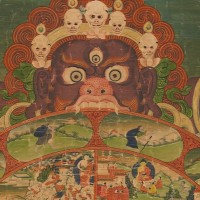
Are we more than just memories? If something suffers, is it alive? What makes a person a sentient being? Fans of the hit HBO series Westworld are steeped in these questions, and the Buddhist art in our galleries has also been asking them for centuries. If Westworld blew your mind, here are just a few of the connections to the show that you can make in our galleries.
Careful—this post contains spoilers!
Remembering Past Lives
“Every host needs a backstory” —Robert Ford

Visitors come to the amusement park Westworld to escape their lives, indulge in their vices, and do whatever they please to the android hosts with seemingly no consequences. The visitors realize that when they enter Westworld, they are moving into fantasy, but for the hosts of the park, Westworld is the only reality they have ever known. The hosts also die as part of these narratives, but are “reborn” once their bodies have been repaired and their memories wiped.
According to Buddhism, like the hosts, we too are moving through a constructed reality that we mistakenly believe to be real, and we are bound to be reborn again and again through all the realms of existence. The image of the Wheel of Life depicts these worlds for gods, demigods, humans, animals, hungry ghosts, and hell beings. Yama, the god of death, grips the whole wheel, demonstrating how all beings, even the gods, are subject to death.
Like the android hosts in Westworld, sentient beings cannot remember their past lives. But as the series goes on, we see more and more hosts affected by the trauma of their past lives, which aligns with the Buddhist idea that beings feel the karmic effects of their previous lives. For both the hosts and sentient beings, developing a new level of awareness allows them to break out of habitual patterns and reach a true understanding of existence.
Clues to an Awakening
“Arnold’s still trying to change us. To free us. You didn’t slip the reveries into the update, did you? He did. He’s still fighting you.” —Bernard Lowe
What if you found a clue that reveals that your reality is constructed? In Westworld, Dolores finds clues left by her creator, Arnold, that point her along the path to discovering her true self, eventually giving her the ability to break free from her human captors. The main clue is amaze that triggers Dolores’s memories of her past lives.

.png)
We find a parallel in the traditions of Tibet and the Himalayas. According to legend, the great Buddhist master Padmasambhava hid terma, or “treasure teachings,” to be revealed by the right person at the right place and time. These sacred teachings and texts, hidden within the landscape and the memories of his followers, were often unlocked with the use of a physical object, much like the maze. In this painting, Padmasambhava sits holding a terma casket that unlocks secret teachings in the reincarnations of his students.
If Arnold is like Padmasambhava, then Dolores could be compared to a terton, or “treasure revealer,” someone who knew the master in a past life, has a deep connection to him, and can access the hidden teachings. (You can learn more about Padmasambhava and the many treasure revealers across history in our exhibition The Second Buddha: Master of Time.)
Buddha and the Nature of Awakening
“Your imagined sufferings make you lifelike” —Robert Ford

A turning point in Westworld arrives when Robert Ford reveals that Bernard is in fact a host and not a human. When Bernard therefore questions why Ford intentionally embedded painful memories of losing a child in him, Ford responds, “Your imagined sufferings make you lifelike.” Indeed in Buddhism, suffering is unavoidable in human life, so it’s no wonder that these “imagined sufferings” make Bernard and other hosts seem more real.
Buddhism also teaches that if we can get rid of desire, we get rid of suffering by following the Buddha’s path. Part of this path is discovering that what we think of as a permanent self is merely a collection of different, ever-changing aggregates—more of a fictional idea than a reality. Westworld’s Robert Ford also makes this point when revealing Bernard’s host identity. “The self is a kind of fiction,” he says, “for hosts and humans alike.”
While others, whether it is Padmasambhava, Arnold, or Robert Ford, can help us find the way, ultimately each individual has to figure out the nuances of reality by him or herself And whether you are Buddha or Dolores, that moment is truly an awakening.
Support for The Second Buddha: Master of Time is made possible in part by Bob and Lois Baylis, The Ellen Bayard Weedon Foundation, E. Rhodes and Leona B. Carpenter Foundation, Barbara Bowman, Lisina M. Hoch, and contributors to the 2018 Exhibitions Fund.
The Second Buddha: Master of Time is organized by The Rubin Museum of Art and The Frances Young Tang Teaching Museum at Skidmore College.
Add Your Thoughts
Comments are moderated, and will not appear on this site until the Rubin has approved them.


